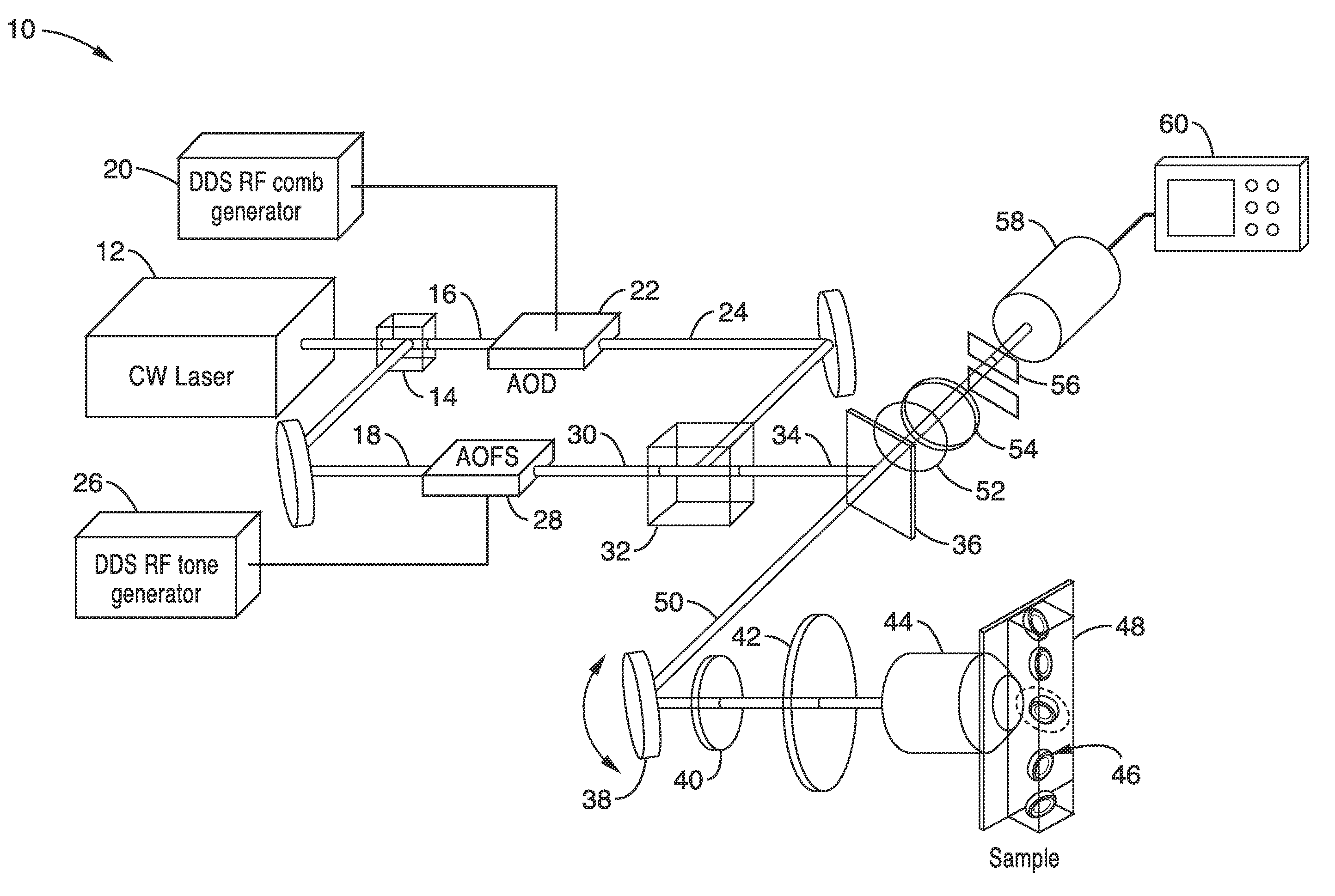Apparatus and methods for fluorescence imaging using radiofrequency-multiplexed excitation
a fluorescence imaging and radiofrequency multiplication technology, applied in the field of optical imaging devices and methods, can solve the problems of pixel crosstalk, the maximum full-frame (512512 pixels) rate, and the time resolution of fluorescence microscopy has not kept up with the advances in spatial resolution, etc., to achieve the effect of immune to pixel crosstalk
- Summary
- Abstract
- Description
- Claims
- Application Information
AI Technical Summary
Benefits of technology
Problems solved by technology
Method used
Image
Examples
example 1
[0081]In order demonstrate the operational principles of FIRE microscopy, a sample of immobilized 15-μm diameter fluorescent polystyrene beads were imaged using 256 excitation frequencies spaced by 300 kHz (total bandwidth of 76.8 MHz). The images were collected at a frame rate of 4.2 kHz. The detected time-domain PMT signal offers no indication of the lateral bead location. A fast Fourier transform (FFT) of three windows of the signal was used to indicate the different frequency components associated with the positions of each bead.
[0082]This illustrated the frequency-to-space mapping of the sample excitation and emission. The vertical location of the beads in the image was recovered from the reference output of the resonant scan mirror. To avoid nonlinear space-to-time mapping from the resonant scan mirror in the vertical direction, an aperture is placed in the intermediate image plane to limit the sample excitation to the linear portion of the scan field, and a sine correction al...
example 2
[0086]To demonstrate FIRE microscopy on biological samples, adherent cells stained with various fluorophores were imaged at a frame rate of 4.4 kHz. NIH 3T3 mouse embryonic fibroblasts, C6 astrocyte rat glial fibroblasts and Saccharomyces cerevisiae yeast were stained with a fluorescent cytosol stain (Calcein AM) or nucleic acid stain (Syto16). NIH 3T3 and MCF-7 cells and C6 astrocytes were propagated in Dulbecco's Modified Eagle Medium with 10% fetal bovine serum and 1% penicillin streptomycin at 37° C. and 5% CO2. Liquid cultures of Saccharomyces cerevisiae were grown in tryptic soy broth at 240 rpm and 37° C.
[0087]Prior to staining, cultured mammalian cells were released from culture flasks, seeded on glass slides, and allowed to spread for 24 hours. Mammalian cells were stained with either 4 μM Syto16 green fluorescent nucleic acid stain in phosphate buffered saline (PBS) for 30 minutes, 1 μM Calcein Red-Orange AM in culture media for 45 minutes, or 1 μM Calcein AM in culture me...
example 3
[0092]Flow cytometry is an application that requires high-speed fluorescence measurements. Compared to single-point flow cytometry, imaging flow cytometry provides information that can be particularly useful for high-throughput rare cell detection. The high flow velocities associated with flow cytometry demand fast imaging shutter speeds and high-sensitivity photodetection to generate high-SNR, blur-free images. Conventional imaging flow cytometers use time delay and integration CCD technology to circumvent this issue, but the serial pixel readout strategy of this technology currently limits devices to a throughput of approximately 5,000 cells per second.
[0093]To demonstrate high-speed imaging flow cytometry using FIRE, a single stationary line scan of 125 pixels spaced by 800 kHz (pixel readout rate of 100 MHz, line scan rate of 800 kHz) was used to image Syto16-stained MCF-7 human breast carcinoma cells flowing in a microfluidic channel at a velocity of 1 m s−1. Assuming a cell di...
PUM
| Property | Measurement | Unit |
|---|---|---|
| frequencies | aaaaa | aaaaa |
| frequencies | aaaaa | aaaaa |
| velocity | aaaaa | aaaaa |
Abstract
Description
Claims
Application Information
 Login to View More
Login to View More - R&D
- Intellectual Property
- Life Sciences
- Materials
- Tech Scout
- Unparalleled Data Quality
- Higher Quality Content
- 60% Fewer Hallucinations
Browse by: Latest US Patents, China's latest patents, Technical Efficacy Thesaurus, Application Domain, Technology Topic, Popular Technical Reports.
© 2025 PatSnap. All rights reserved.Legal|Privacy policy|Modern Slavery Act Transparency Statement|Sitemap|About US| Contact US: help@patsnap.com



